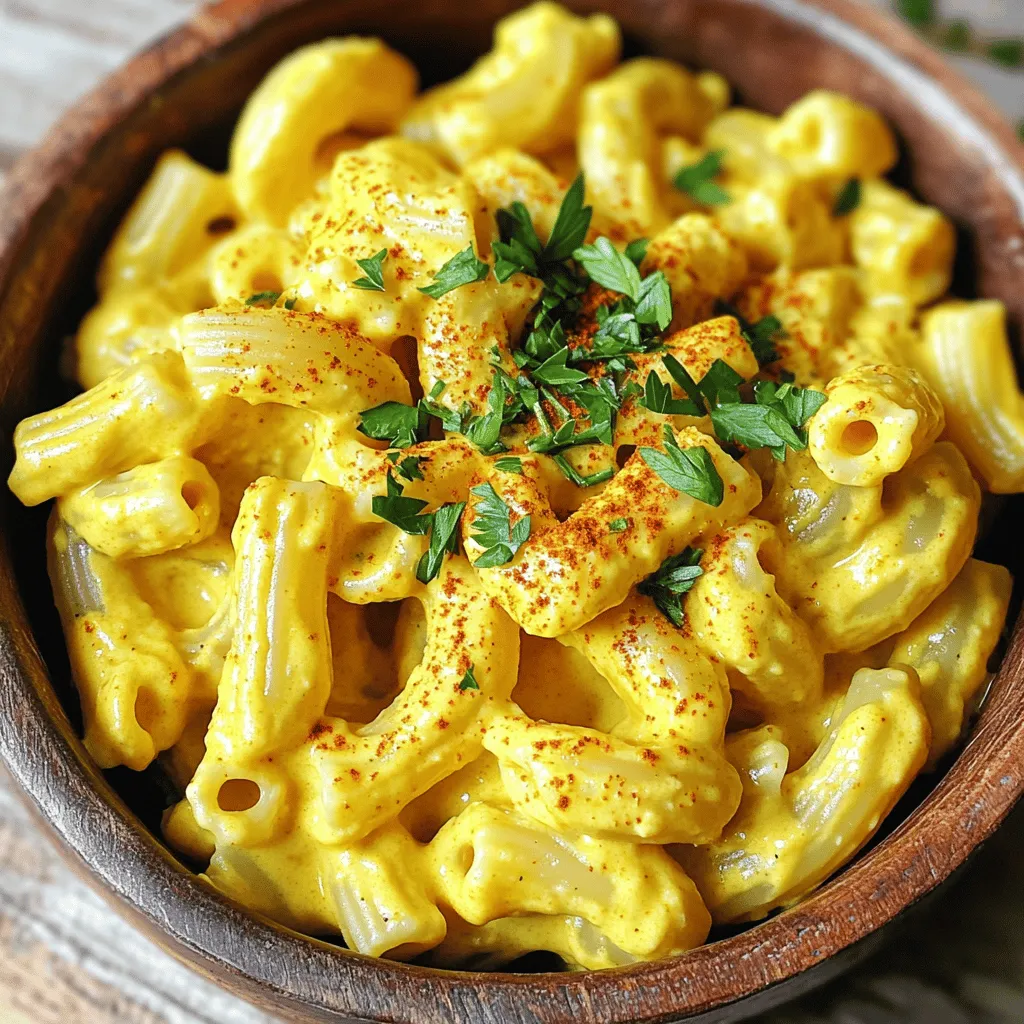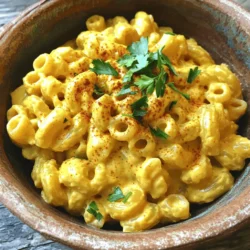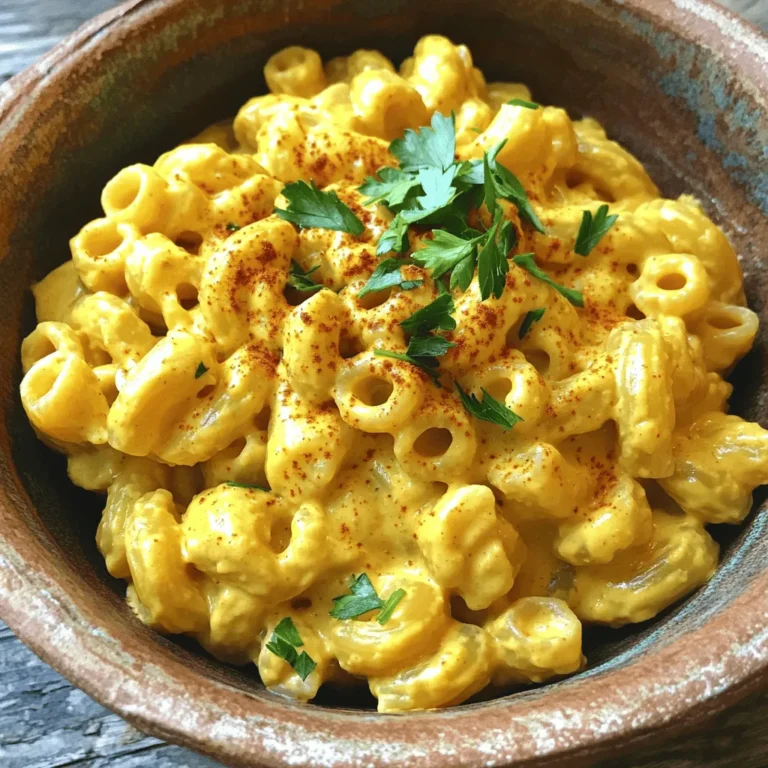Are you craving a dish that’s both comforting and creamy? My Vegan Mac and Cheese will satisfy your taste buds without any guilt. Packed with rich flavors and simple ingredients, this dish is perfect for everyone, including those with dietary restrictions. In this guide, I’ll walk you through essential ingredients, easy steps, and tips to make it just right. Let’s dive in and create a bowl of pure joy!
Ingredients
Essential Ingredients for Vegan Mac and Cheese
For a great vegan mac and cheese, you need these key ingredients:
– 2 cups elbow macaroni
– 1 cup raw cashews (soaked for at least 2 hours)
– 1/4 cup nutritional yeast
– 1/2 cup almond milk (or other plant-based milk)
– 2 tablespoons lemon juice
– 1 tablespoon Dijon mustard
– 1/2 teaspoon garlic powder
– 1/2 teaspoon onion powder
– Salt and pepper to taste
These ingredients work together to create a creamy and rich sauce. The cashews give a smooth texture, while the nutritional yeast adds a cheesy flavor.
Optional Ingredients for Added Flavor
If you want to enhance your vegan mac and cheese, consider these optional ingredients:
– 1/4 teaspoon smoked paprika
– Fresh parsley, chopped (for garnish)
Smoked paprika gives a nice depth and warmth. Fresh parsley adds a pop of color and freshness to the dish.
Substitute Options for Common Allergens
You can easily swap out some ingredients if you have allergies. Here are some options:
– Use gluten-free pasta instead of regular elbow macaroni.
– Replace cashews with sunflower seeds for a nut-free version.
– Use oat milk or soy milk if almond milk is not suitable.
These substitutions keep your dish tasty while catering to dietary needs. Remember, cooking is all about customizing to your taste!
Step-by-Step Instructions
Cooking the Elbow Macaroni
Start by boiling water in a large pot. Add a pinch of salt to the water. Once the water boils, add 2 cups of elbow macaroni. Cook the pasta for about 8 to 10 minutes. Stir occasionally to prevent sticking. When done, drain the pasta in a colander. Rinse with cold water to stop the cooking process. Set the macaroni aside while you make the cheese sauce.
Making the Cashew Cheese Sauce
For the cheese sauce, you need a blender. First, soak 1 cup of raw cashews for at least 2 hours. Drain the cashews and add them to the blender. Next, add 1/4 cup of nutritional yeast and 1/2 cup of almond milk. Squeeze in 2 tablespoons of lemon juice and add 1 tablespoon of Dijon mustard. Toss in 1/2 teaspoon of garlic powder and 1/2 teaspoon of onion powder. If you want a smoky taste, include 1/4 teaspoon of smoked paprika. Blend this mix on high until it’s smooth and creamy. If the sauce is too thick, add more almond milk until you reach the right texture.
Combining Pasta and Sauce
Now it’s time to mix the pasta and sauce. Pour the cashew cheese sauce into a large pot set over low heat. Stir it continuously until warm, which takes about 2-3 minutes. Next, gently fold the cooked elbow macaroni into the sauce. Make sure all the pasta is coated well. Cook for another 2 minutes to let the flavors blend together. Taste the dish and adjust the seasoning with salt and pepper if needed. Serve hot, and don’t forget to garnish with fresh parsley for a pop of color and taste.
Tips & Tricks
How to Make the Creamiest Sauce
To create the creamiest sauce, start with soaked cashews. Soaking helps them blend smoothly. Use a high-speed blender for best results. Combine soaked cashews with almond milk and nutritional yeast. Blend until you achieve a velvety texture. If your sauce is too thick, add more almond milk slowly. This keeps it creamy without losing flavor.
Adjusting Flavor Profiles
To adjust flavors, taste your sauce as you go. Add a pinch of salt for depth. Lemon juice gives it a bright kick. If you prefer a tangy twist, try more Dijon mustard. Smoked paprika adds a nice warmth if you want it. Feel free to mix and match spices to find your perfect taste.
Cooking Time Tips
When cooking the pasta, follow package directions for best results. Drain the pasta well to avoid excess water. When adding the sauce, cook on low heat. Stir gently to coat the pasta without breaking it. Keep it on the heat for a few minutes. This helps meld the flavors together perfectly. For the best outcome, serve it hot right away.

Variations
Gluten-Free Vegan Mac and Cheese
You can easily make vegan mac and cheese gluten-free. Just use gluten-free elbow macaroni. Many brands offer great options. Follow the same cooking steps from the recipe. Your cheese sauce will still be creamy and tasty.
Nut-Free Vegan Cheese Alternatives
If you need a nut-free cheese alternative, try sunflower seeds. Sunflower seeds give a nice, creamy texture. Soak them like you do with cashews. Blend them with the same ingredients from the recipe. You can also use store-bought nut-free vegan cheese for a quicker option.
Adding Vegetables for Extra Nutrition
Adding veggies makes your vegan mac and cheese even better! Spinach, broccoli, or peas work well. Cook them with the pasta for just a few minutes. Then mix them into your cheese sauce. This adds color and boosts nutrition. You can feel good about your meal!
Storage Info
How to Store Leftover Vegan Mac and Cheese
To keep leftover vegan mac and cheese fresh, place it in an airtight container. Make sure to cool it to room temperature first. Then, seal the lid tightly. This helps prevent air from getting in and drying out your dish. You can store it in the fridge for up to five days. If you want to keep it longer, freeze it for up to three months.
Reheating Techniques
Reheating vegan mac and cheese is easy. You can use a microwave or a stovetop. For the microwave, place a portion on a plate, cover it with a damp paper towel, and heat for one to two minutes. Stir it halfway through to warm evenly. On the stovetop, add the mac and cheese to a pot. Add a splash of almond milk to help it stay creamy. Heat over low heat, stirring often until warm.
Shelf Life of Ingredients
The shelf life of your ingredients can affect your dish. Raw cashews last about six months in a cool, dry place. Nutritional yeast can last up to two years if stored in a cool, dark area. Almond milk usually stays good for seven to ten days after opening. Always check the expiration dates on your ingredients to ensure freshness.
FAQs
What are the best vegan cheese alternatives?
The best vegan cheese alternatives include cashew cheese, almond cheese, and coconut cheese. Cashew cheese works well in mac and cheese. It has a creamy texture and a mild flavor. Nutritional yeast also adds a cheesy taste. You can find many brands of vegan cheese in stores. Look for ones that melt well for the best results.
Can I make this dish oil-free?
Yes, you can make this dish oil-free. Use raw cashews as your base. They create a creamy texture without oil. Add almond milk for extra smoothness. Nutritional yeast adds flavor without added fat. Just be sure to blend until smooth. This keeps your mac and cheese rich and creamy without oil.
How do I make vegan mac and cheese spicier?
To make vegan mac and cheese spicier, add some hot sauce. You can also sprinkle in cayenne pepper or chili powder. Start with a small amount and taste as you mix. Adjust the heat to your liking. You can even add diced jalapeños for a fresh kick. These changes give your dish an exciting twist!
In this post, we explored the best ingredients for vegan mac and cheese. You learned how to create a creamy cashew sauce and cook perfect pasta. We discussed tips for customizing the flavors and making it gluten-free or nut-free. I shared how to store leftovers and answered common questions.
Vegan mac and cheese can be easy and fun. With these ideas, you can enjoy a dish that is tasty and good for you. Try out your favorite ingredients and share your results!


